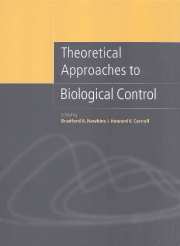Book contents
- Frontmatter
- Contents
- List of contributors
- Preface
- Part I Biological control theory: past and present
- Part II Ecological considerations
- 4 The uniformity and density of pest exploitation as guides to success in biological control
- 5 Biological control of insect pests: a tritrophic perspective
- 6 The case for indigenous generalists in biological control
- 7 Why is the parasitoid Encarsia formosa so successful in controlling whiteflies?
- 8 Parasitoid adult nutritional ecology: implications for biological control
- 9 Coexistence of multiple attractors and its consequences for a three-species food chain
- Part III Spatial considerations
- Part IV Genetic/evolutionary considerations
- Part V Microbes and pathogens
- Index
7 - Why is the parasitoid Encarsia formosa so successful in controlling whiteflies?
from Part II - Ecological considerations
Published online by Cambridge University Press: 13 August 2009
- Frontmatter
- Contents
- List of contributors
- Preface
- Part I Biological control theory: past and present
- Part II Ecological considerations
- 4 The uniformity and density of pest exploitation as guides to success in biological control
- 5 Biological control of insect pests: a tritrophic perspective
- 6 The case for indigenous generalists in biological control
- 7 Why is the parasitoid Encarsia formosa so successful in controlling whiteflies?
- 8 Parasitoid adult nutritional ecology: implications for biological control
- 9 Coexistence of multiple attractors and its consequences for a three-species food chain
- Part III Spatial considerations
- Part IV Genetic/evolutionary considerations
- Part V Microbes and pathogens
- Index
Summary
Introduction
Of the 1200 described whitefly species, only some 20 may be considered as potential pests. Until recently most research on control of whiteflies was directed towards the greenhouse whitefly (Trialeurodes vaporariorum (Westwood)) (van Lenteren & Woets, 1988). However, since the mid-1980s, whiteflies of the genus Bemisia have created problems of such a large scale both in the field and in large, commercial greenhouses that research has shifted to this pest (Gerling, 1990; Gerling & Mayer, 1996; van Lenteren et al., 1997). Greenhouse whitefly (Trialeurodes vaporariorum) and silverleaf whitefly (Bemisia argentifolii) are very common, highly polyphagous pest insects worldwide. Biological control of greenhouse whitefly with the parasitoid Encarsia formosa was first applied in 1926 and has since been used with great commercial success.
Usually, in natural ecosystems and agroecosystems where pesticides are not (or selectively) used, an array of natural enemies keeps the number of whiteflies at very low levels: predators, parasitoids, and pathogens all take their toll. Examples from cotton and tomato show that both whitefly species can be kept at densities well below the economic threshold (van Lenteren et al., 1996). If natural control is insufficient, inoculative or inundative releases with natural enemies can be made. Commercial biological control of greenhouse white-fly through releases of the parasitoid Encarsia formosa Gahan is used at present on about 5000 ha of greenhouse crops and in most countries with an important greenhouse industry (van Lenteren, 1995).
- Type
- Chapter
- Information
- Theoretical Approaches to Biological Control , pp. 116 - 130Publisher: Cambridge University PressPrint publication year: 1999
- 5
- Cited by



